Table of Contents
1. What Is Good Customer Service?
2. Why Good Customer Service Matters?
3. Key Elements of Good Customer Service
4. Real-Life Examples of Good Customer Service
5. How to Measure Good Customer Service
6. Common Challenges in Delivering Good Customer Service
7. Best Practices for Delivering Good Customer Service
8. The Role of Technology in Enhancing Customer Service
Good customer service is the foundation of a successful business. It is built on consistently exceeding customer expectations and fostering trust-based relationships that turn occasional customers into loyal advocates of the brand.
For example, businesses such as Amazon, Nordstrom, Chick-fil-A, and Ritz-Carlton have established standards for effective customer service. These organizations enjoy advantages such as improved customer loyalty, a robust brand image, and continued expansion. They show that outstanding service is a support function and a strategic asset in competitive markets.
Today’s consumers demand faster responses, smooth interaction across platforms, and experiences customized to their preferences. According to PwC, nearly 80% of American consumers say that speed, convenience, knowledgeable help, and friendly service are the most important elements of a positive customer experience.
In other words, personalization, combined with promptness and empathy in responses, is now crucial to meet these evolving expectations.
In this article, we will understand what good customer service is, its significance, key elements, and some successful strategies and practical examples.
What Is Good Customer Service?
Good customer service is about creating meaningful interactions that consistently exceed expectations. It focuses on value beyond transactional problem-solving and ensures customers feel acknowledged, respected, and valued. This promotes trust and turns customers into loyal advocates.
Empathy is central to good customer service, involving more than resolving complaints—it’s understanding emotions and context.
For instance, when a delivery is delayed, an empathetic response might include a heartfelt apology, proactive updates, and a gesture like a discount or priority shipping. These actions show customers they are valued, reinforcing emotional connections.
Understanding the customer journey is another key aspect. Businesses must anticipate needs before issues arise. Predictive technologies, for example, can notify customers about delays or recommend upgrades based on history, ensuring a proactive approach.
Agility in problem resolution is also vital. Customers today expect tailored solutions rather than generic responses. A personalized approach, such as extending a return period for a loyal customer, demonstrates flexibility and respect, prioritizing the relationship over policies.
Good customer service evolves with changing expectations. Businesses that embrace personalization, proactive engagement, and flexibility leave lasting impressions. This helps them turn satisfied customers into advocates, solidifying the brand’s reputation in competitive markets.
Why Good Customer Service Matters?
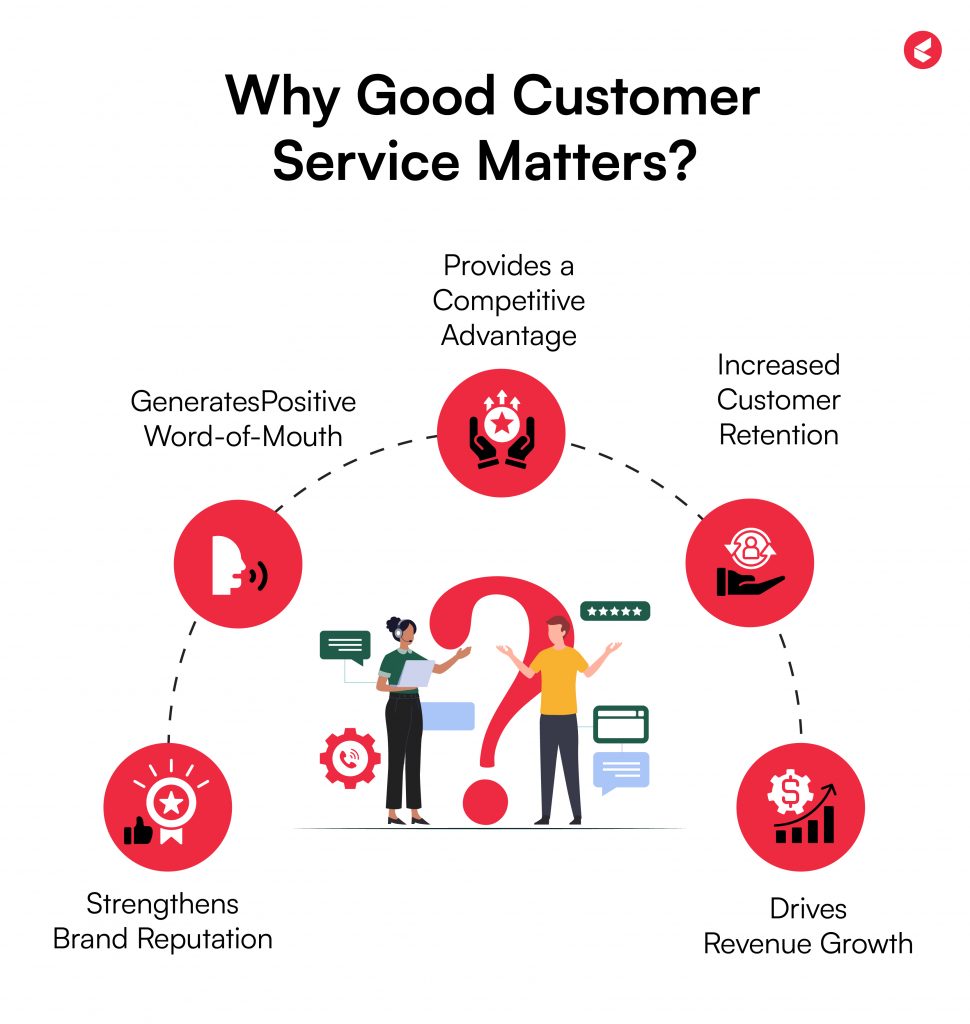
Excellent customer service provides extensive advantages that boost customer loyalty, increase revenue, and improve competitive position.
It’s not merely about addressing problems; it’s about fostering enduring relationships that encourage customers to return and promote your brand.
1. Increased Customer Retention
It is cheaper to retain existing customers than to acquire new ones. Additionally, a loyal customer is likely to buy again and spend more in the long run.
For instance, an existing customer may opt for higher-margin products or services, increasing overall profitability. Furthermore, companies that focus on retention experience an improved Customer Lifetime Value, which is a key metric for long-term growth.
Customer Lifetime Value, in essence, represents an essential long-term growth factor, for which the predictability of revenues and the expansion process with low costs can result in higher advocacy through the positive word-of-mouth publicity generated.
2. Generates Positive Word-of-Mouth
Satisfied customers naturally promote the brand. They communicate their positive experiences, creating invaluable word-of-mouth recommendations that support businesses’ growth.
Statista reports that around 90% of worldwide consumers have faith in suggestions from acquaintances. This emphasizes how both conventional word-of-mouth and online platforms influence consumer behavior in today’s interconnected world.
For instance, take Tesla into account. The brand has attained significant growth and recognition mainly through word-of-mouth support. Tesla owners frequently express their positive experiences on social platforms or with friends, emphasizing the vehicles’ advanced features, ecological advantages, and remarkable performance.
Positive word-of-mouth improves a brand’s reputation and lowers marketing costs by creating a community of loyal supporters.
3. Provides a Competitive Advantage
In bustling markets, customer service may be a crucial differentiator. When products and pricing are alike, outstanding service distinguishes companies. Research by Microsoft indicates that 90% of Americans consider customer service an essential element in determining whether to engage with a company.
Companies such as Nordstrom, Chick-fil-A, and The Ritz-Carlton have established their supremacy by emphasizing customer satisfaction, demonstrating that outstanding service can result in market leadership. Firms with a strong reputation for excellent service often attract and retain top talent, as employees are drawn to organizations that prioritize customer satisfaction and uphold a positive brand image.”
4. Drives Revenue Growth
Customer experience directly influences buying choices. According to a report by PwC, 73% of customers say a positive experience is among the key drivers of their purchasing decisions.
Furthermore, 74% of customers have migrated to a rival because of inadequate service, which includes long wait times, a lack of voice/phone customer service, limited 24/7 support, and insufficient self-service options. This information emphasizes the financial dangers associated with ignoring customer service.
Companies that exceed expectations often see higher average order values and cross-selling opportunities due to increased trust.
5. Strengthens Brand Reputation
A strong service culture enhances brand perception and builds trust. Brands that consistently deliver empathetic and effective customer service are seen as reliable and customer-focused.
This reputation acts as a buffer during crises or negative experiences, as customers are more forgiving of occasional mistakes when a history of excellent service exists. Additionally, a customer-centric reputation can attract strategic partnerships and investments, further boosting business growth.
Key Elements of Good Customer Service
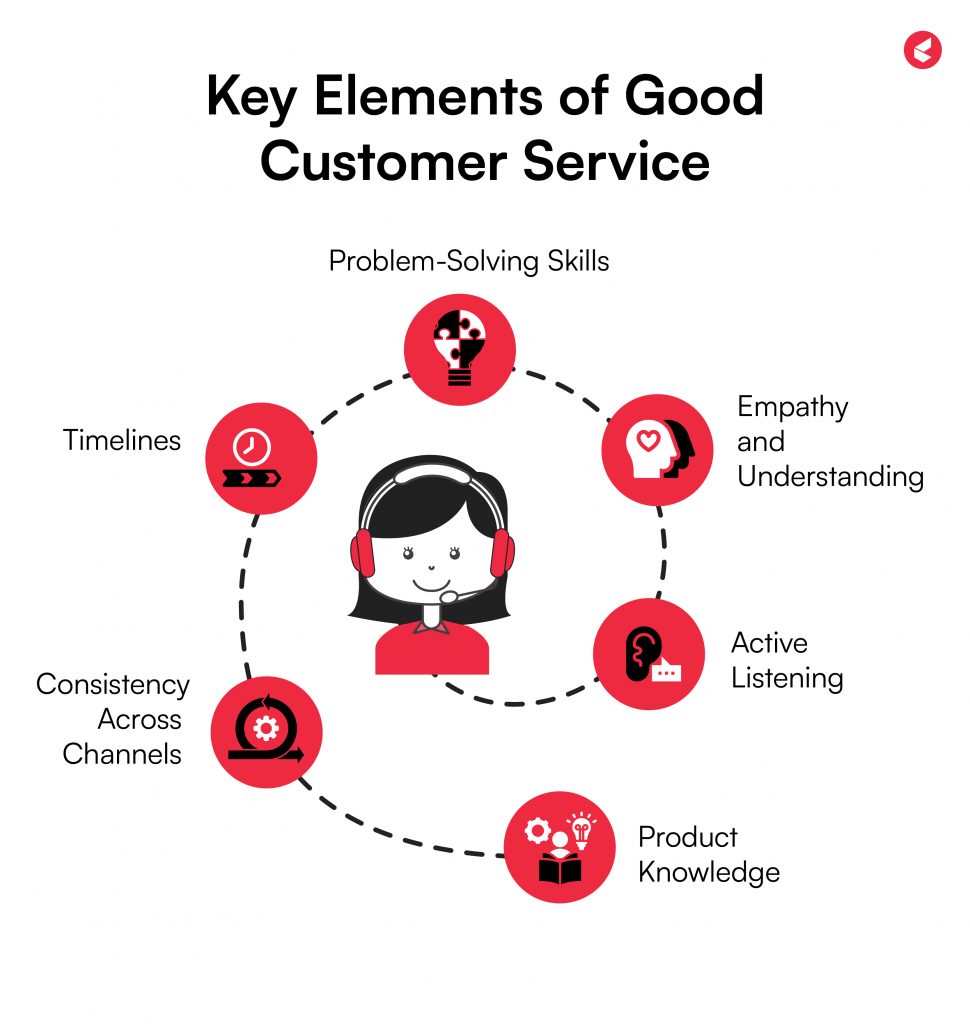
Effective customer service is based on essential principles that guarantee each customer interaction adds value and is meaningful for the customer. Each component is crucial for ensuring smooth, enjoyable customer experiences and encouraging enduring loyalty.
1. Active Listening
Active listening is essential for understanding customer needs and offering effective solutions. It means listening carefully to the customer, making sure their concerns are heard and understood without interruptions or assumptions.
- Why It’s Essential: Active listening is essential because it provides insights into the root cause of every issue. This helps prevent miscommunication and makes customers feel valued.
- Actionable Example: Train agents to repeat back key points to confirm understanding. For instance, when a customer describes a recurring issue with a product, an agent might say, “I understand the issue occurs after prolonged use. Let’s address that for you immediately.”
2. Empathy and Understanding
Empathy enables companies to relate to customers at a personal level, showing them how genuinely interested they are in solving any problem.
- Why It’s Essential: Clients will more likely be loyal and trusting to a brand that is able to show empathy and understanding.
- Actionable Example: Encourage agents to acknowledge emotions before resolving issues. For example, “I can see how this delay must have been frustrating. Let’s resolve this quickly for you.”
3. Problem-Solving Skills
Effective problem-solving ensures customers leave interactions with their issues fully resolved and their expectations exceeded.
- Why It’s Essential: Quick and creative solutions boost customer confidence in the brand’s capability and professionalism.
- Actionable Example: Equip agents with clear escalation protocols and decision-making authority. For quicker resolutions, agents can offer refunds or replacements without managerial approval.
4. Timelines
Customers value their time and expect prompt responses and solutions to their queries.
- Why It’s Essential: Timely resolutions demonstrate efficiency and reliability, enhancing customer satisfaction, building trust, and strengthening loyalty.
- Actionable Example: Implement chatbots to handle initial queries swiftly, offering instant resolutions for common concerns like order tracking or FAQs. For more complex issues, provide automated acknowledgment messages to reassure customers and ensure live chat agents respond within 30 seconds. Establish clear timelines for resolution and follow up proactively to maintain customer satisfaction.
5. Consistency Across Channels
Ensuring a consistent experience across all customer service channels is essential for establishing trust.
- Why It’s Essential: Customers desire smooth channel shifts without reiterating their issues.
- Actionable Example: Use omnichannel systems to monitor customer engagements. The representative can retrieve prior messages for context if a customer transitions from email to phone assistance.
6. Product Knowledge
In-depth product knowledge allows agents to offer accurate and relevant solutions tailored to customer needs.
- Why It’s Essential: Customers trust agents who can confidently address questions and provide meaningful recommendations.
- Actionable Example: A technology retailer ensures all customer support agents undergo quarterly training sessions on new product features and updates. For instance, an agent helping a customer troubleshoot a laptop issue might confidently recommend an upgraded accessory like a compatible docking station, showcasing both product knowledge and proactive problem-solving.
Real-Life Examples of Good Customer Service
Real-life examples illustrate how exceptional customer service resolves issues and transforms ordinary interactions into memorable experiences. Such examples highlight the strategies and actions that leave a lasting impression and foster customer loyalty.
1. Amazon: Proactive Resolutions for Customer Satisfaction
Amazon’s commitment to good customer service is evident in its proactive approach to resolving issues.
- Scenario: A customer reported not receiving a package despite it being marked as delivered. Instead of placing blame, Amazon promptly issued a replacement order and upgraded the shipping at no extra cost.
- USP: Amazon’s quick response minimized frustration and restored the customer’s trust in the brand. Their proactive handling reflects a customer-first philosophy that values loyalty over short-term costs.
- Takeaway: Businesses can emulate this by empowering agents to act swiftly and prioritize customer satisfaction during disputes for prompt resolutions.
2. Zappos: Building Emotional Connections
Zappos has a great reputation for providing exceptional customer service. Its vision is “to provide WOW through service.”
- Scenario: The customer had ordered something that was delayed due to a logistics problem. She needed the item for a wedding. Zappos upgraded the shipping and expedited the replacement at the convenience of on-time delivery. Plus, the agent sent a handwritten note to wish the couple a happy wedding day.
- USP: This thoughtful action transformed a potentially unpleasant experience into a lasting memory. It demonstrates the brand’s understanding and its eagerness to exceed typical solutions. Takeaway: Businesses need to educate their teams to focus on empathy and personalization, building significant relationships that enhance customer loyalty and trust.
3. Ritz-Carlton: Empowering Employees to Exceed Expectations
The culture of great service by The Ritz-Carlton enables support personnel to solve problems independently without awaiting managerial consent.
- Scenario: One family had forgotten their child’s favorite stuffed toy at a Ritz-Carlton hotel. The staff shipped the toy back and also created a photo album of the stuffed animal enjoying various “adventures” around the hotel.
- USP: The team transformed a simple lost-and-found case into a delightful experience that the family cherished. It showcased creativity, thoughtfulness, and a commitment to exceeding expectations.
- Takeaway: Equip employees with the autonomy and resources to personalize customer experiences, creating moments that leave a lasting impression and strengthen brand loyalty.
How to Measure Good Customer Service?
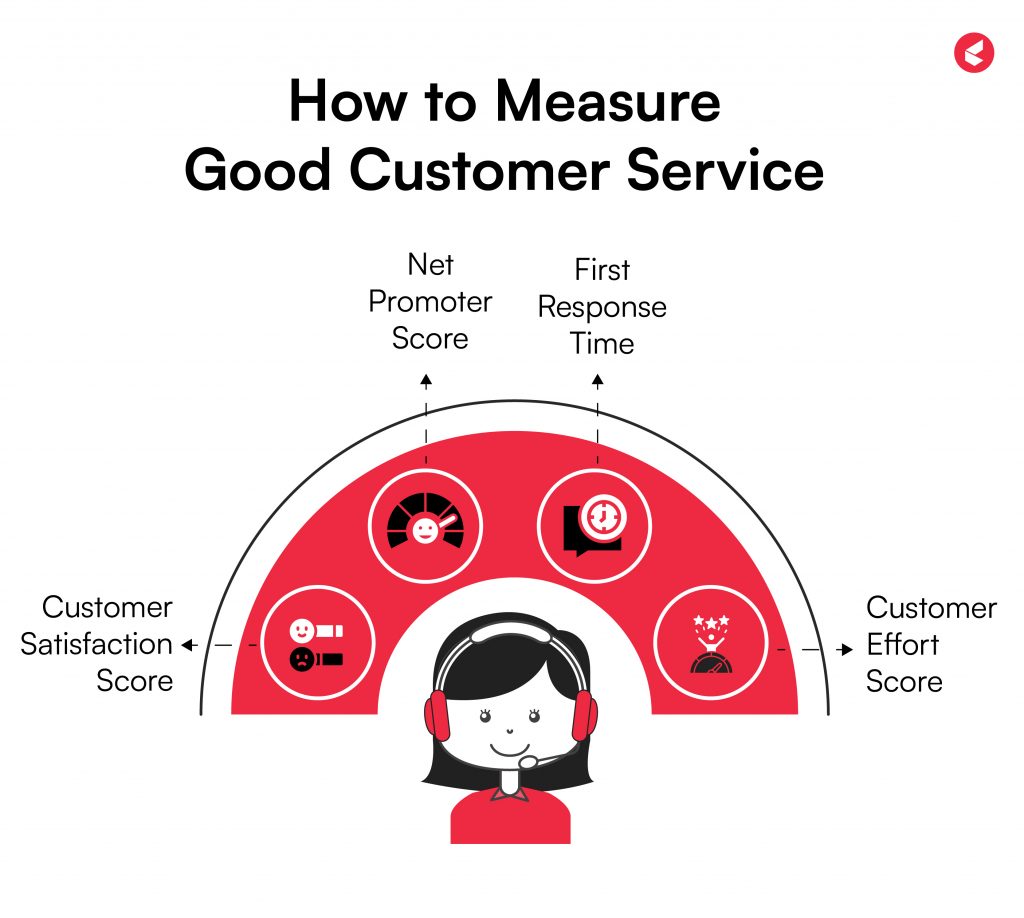
Good customer service has to make use of certain metrics, which will be beneficial in gaining valuable insight into the quality and efficiency of the service. These metrics help the business to learn about its performance, understand areas that need improvements, and enhance the overall customer journey.
The key methods to measure good customer service effectively are as follows:
1. Customer Satisfaction Score (CSAT)
CSAT, in general, refers to the metric that measures customer satisfaction via surveys about an interaction, product, or service.
- How It Works: It asks customers to rate their satisfaction on a scale of 1-5 or 1-10. The CSAT score is calculated based on the percentage of positive responses, typically from options like ‘satisfied’ and ‘very satisfied.
- Formula: The formula is CSAT= count of positive replies/ overall count of replies X 100. For instance, if you obtained 50 responses, and 30 of those are positive, the CSAT score would be 60%. Insights Gained: A high CSAT score indicates that the service has fulfilled or exceeded customer expectations. Monitoring this metric over time may show patterns in customer satisfaction, thus proactive improvements.
- Example: An organization sends a CSAT survey post-query resolution to measure customer satisfaction with the support provided. This feedback helps identify service gaps, improve resolution processes, and maintain high satisfaction levels by acting on customer insights.
2. Net Promoter Score (NPS)
NPS is the degree of consumer loyalty based on the percentage of consumers that would recommend the business to others.
- How It Works: Customers give a rating of 0 to 10 on how likely they are to recommend it. Then, the scores are classified into promoters in the 9-10 range, passives in the 7-8 range, and detractors in the 0-6 range.
- Formula: The formula is: NPS = percentage of promoters – percentage of detractors. For example, if 20% of the total responses are from detractors, 20% are passives, and 60% are promoters, your NPS score would be 60-20 = 40.
- Insights Gained: NPS is one of the vital metrics for judging brand reputation. A high NPS score indicates high customer loyalty and satisfaction, while low scores indicate areas that need attention.
- Example: Businesses use NPS to identify their most loyal customers (promoters) who can become brand advocates through referral programs. Simultaneously, detractors’ feedback helps uncover recurring issues, enabling targeted improvements to enhance satisfaction and loyalty.
3. First Response Time (FRT)
FRT measures the time taken to respond to a customer’s initial query.
- How It Works: This metric tracks the average time between a customer’s contact and the first reply from the support team.
- Formula: The formula is: First Response Time=Time of First Response−Time of Customer Query. For example, if the customer query time is 10:00 AM and the first response time is 10:30 AM, the first response time is 30 minutes.
- Insights Gained: A low FRT indicates efficiency and respect for customer time, both critical components of good customer service. Delays in response can frustrate customers and harm trust.
- Example: Using a live chat tool with predefined response benchmarks ensures faster acknowledgments and quicker resolutions. This reduces FRT and enhances customer satisfaction by addressing their concerns promptly, fostering trust and a positive experience.
4. Customer Effort Score (CES)
CES evaluates how easy it is for customers to resolve their issues or complete interactions.
- How It Works: Customers rate their experience on a scale, typically indicating how much effort was required. Lower effort equals a better score.
- Formula: The formula is CES = Total Effort Scores / Total Number of Responses. For example, if 50 customers rate their effort on a scale of 1–5 and the total score is 120, the CES would be 120 / 50 = 2.4
- Insights Gained: A low CES highlights the simplicity of the customer journey. It reflects well-designed processes and effective problem-solving.
- Example: A business can use CES surveys to measure how easily customers resolve issues using self-service portals or through support teams. A lower CES score indicates smoother interactions, reducing customer frustration and encouraging repeat engagement. This insight helps businesses identify and address pain points in their processes to enhance the customer journey.
Common Challenges in Delivering Good Customer Service
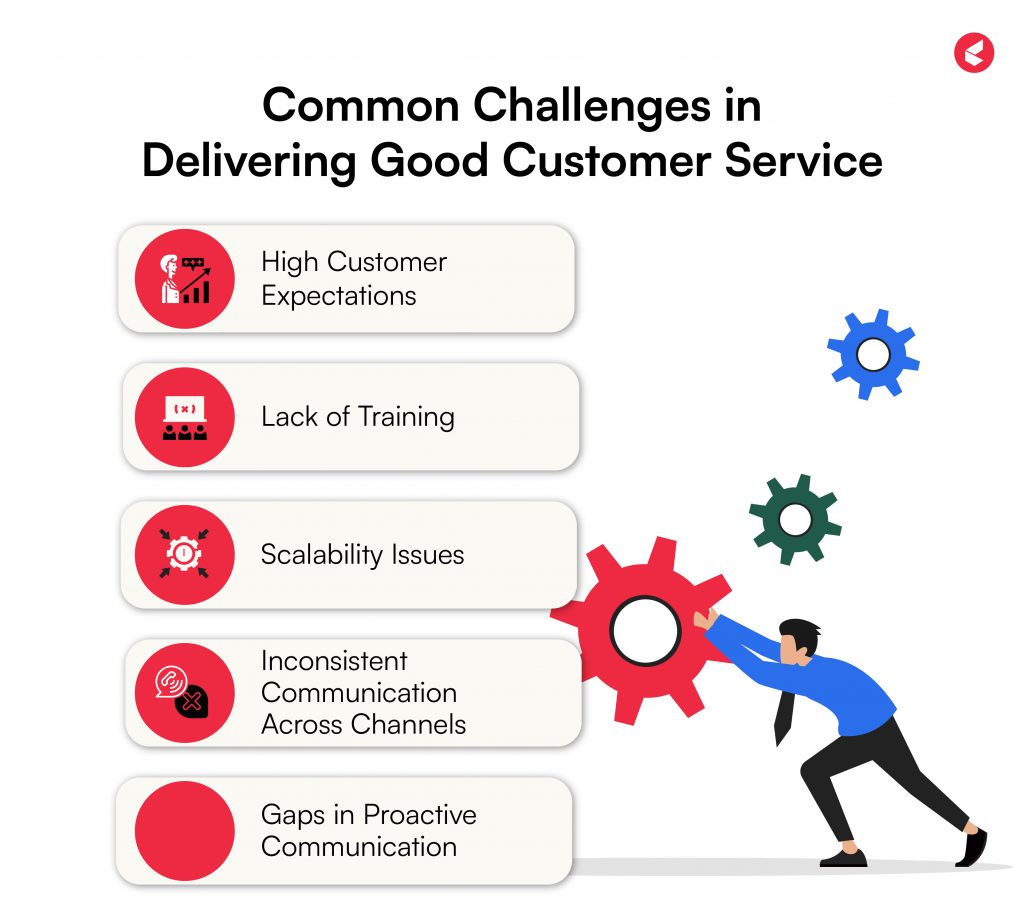
Good customer service does indeed have its challenges, especially with constantly changing customer expectations and business growth. These might hinder the quality and efficiency of the service, but there are always ways to overcome them. Below are some common challenges and their corresponding solutions.
1. High Customer Expectations
Today’s customers want speed, personalization, and seamlessness across every touchpoint. Meeting these increased expectations can be daunting.
- The Challenge: Some customers want quicker responses, services at any time, and uniform service across each touch point. Any single delay or wrong move can result in dissatisfaction.
- Solution: Employ AI-driven chatbots and an omnichannel CX system to provide prompt and effective responses. These technologies will support giving consistent service while managing the high volume of queries received by a business.
2. Lack of Training
Great customer service requires well-trained employees, but so many businesses suffer from poor training programs.
- The Challenge: Untrained agents may not be able to understand and resolve complex issues, which may lead to poor consumer interactions and dissatisfaction.
- The Solution: Invest in more regular training programs to enhance the agents’ problem-solving, empathy, and communicative abilities. Scenarios for role-playing and online learning e-tools will simulate real-world challenges while informing them how to respond to them.
3. Scalability Issues
As businesses expand, maintaining good customer service often becomes more challenging due to increased demands and operational complexities
- The Challenge: Scaling customer service without compromising quality can overwhelm existing support agents.
- Solution: Scalable solutions include cloud-based customer service platforms and automated workflows. These systems allow businesses to handle large volumes of interactions without compromising on service quality.
4. Inconsistent Communication Across Channels
Inconsistent service experiences across multiple channels can frustrate customers and erode trust in the brand.
- The Challenge: Customers experience miscommunication during the transition from one channel to another, say from Live Chat to Phone Support.
- Solution: Omnichannel strategies and access to a centralized system for all customer data will help agents provide frictionless support regardless of the channel used.
5. Gaps in Proactive Communication
Not anticipating customers’ needs may lead to unnecessary complaints or escalations.
- The Challenge: Most businesses only react to problems rather than trying to prevent any potential pain points.
- The Solution: Predictive analytics and customer data can be used to anticipate problems and proactively notify customers. For example, airlines warning passengers of delays can greatly enhance customer satisfaction.
Best Practices for Delivering Good Customer Service
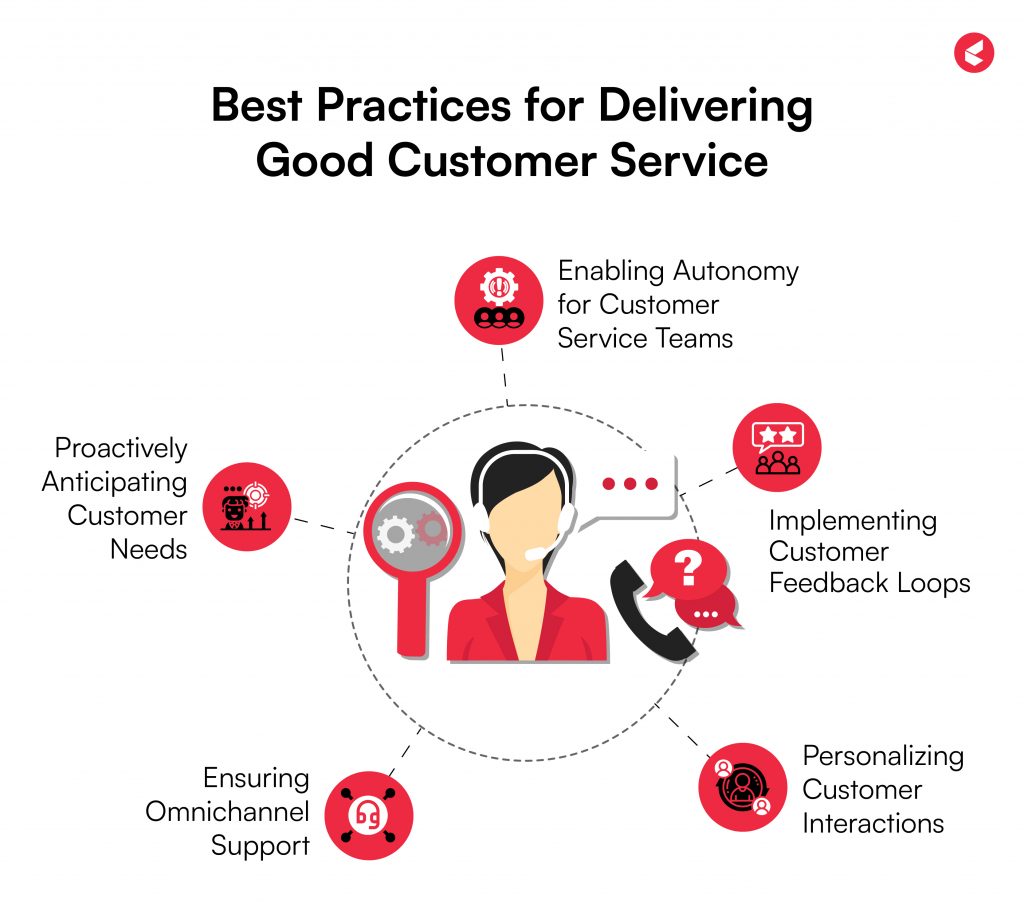
Delivering good customer service requires a strategic approach prioritizing customer satisfaction and operational efficiency. By adopting proven best practices, businesses can consistently exceed expectations and build lasting loyalty.
Below are actionable strategies and real-world examples of how companies implement these approaches effectively.
1. Enabling Autonomy for Customer Service Teams
Providing teams with the authority to make decisions ensures faster resolutions and enhances customer trust.
- Why It’s Essential: Autonomy allows agents to address customer concerns proactively. It reduces dependency on managerial oversight, creating smoother workflows and increasing customer satisfaction.
- Actionable Strategies:
- Train agents to handle escalations independently within defined guidelines.
- Equip teams with tools and knowledge bases to make informed decisions.
- Example: Nordstrom equips its customer service teams with the autonomy to make on-the-spot decisions, such as processing returns without a receipt or offering immediate exchanges. This approach enables employees to resolve customer concerns efficiently, fostering trust and loyalty.
2. Implementing Customer Feedback Loops
Customer feedback is one of the best ways to recognize pain points and ways through which service quality can be improved.
- Why It’s Essential: Feedback acts as a direct channel to understand customer expectations and evolving needs. It enables businesses to address gaps and refine their strategies proactively.
- Actionable Strategies:
- Conduct post-interaction surveys on satisfaction measurement and suggestions.
- Measure customer loyalty using NPS to identify areas for improvement.
- Example: Amazon uses detailed customer feedback to improve its operations. For instance, frequent feedback on packaging led to the introduction of sustainable and frustration-free options that greatly improved customer satisfaction.
3. Personalizing Customer Interactions
Personalization makes customers feel valued, promotes loyalty, and builds stronger, long-lasting relationships with the brand.
- Why It’s Essential: The tailored interactions show that the business is interested and responsive to the needs of individual customers.
- Actionable Strategies:
- Implement CX systems to track the buying history and preferences of customers and make recommendations accordingly.
- Train agents to use the customer’s name and refer to previous interactions.
For example, Stitch Fix is an online styling service that uses various customer-specific information to personalize experiences. Through taste analysis and review feedback, the firm strives to offer curated clothing selections consistent with the customer’s style.
4. Ensuring Omnichannel Support
Omnichannel support means customers have a seamless experience across all channels of communication.
- Why It’s Essential: Customers today use multiple channels to interact with businesses, and a seamless transition between these channels ensures a frustration-free experience.
- Actionable Strategies:
- Implement an omnichannel platform to centralize customer data and interaction history.
- Training agents to handle queries coming in through multiple platforms—live chats, emails, and social networking sites.
- Example: Starbucks does extremely well in omnichannel support, allowing its customers to interact through mobile apps, in-store or online. These interactions are integrated and thus continue the seamless service, whether the customer is placing an order, receiving rewards, or resolving any query.
5. Proactively Anticipating Customer Needs
Being proactive allows businesses to resolve potential issues before they escalate.
- Why It’s Essential: Anticipating customers’ needs builds trust and a commitment to their satisfaction.
- Actionable Strategies:
- Leverage AI and predictive analytics to identify issues common in customer journeys and solve them in advance.
- Inform customers about delays or disruptions before they have to call in.
- Example: Netflix will send proactive alerts to its customers whenever someone accesses an account from a new device. This is a step toward better security and assures customers that the company also considers their safety.
The Role of Technology in Enhancing Customer Service
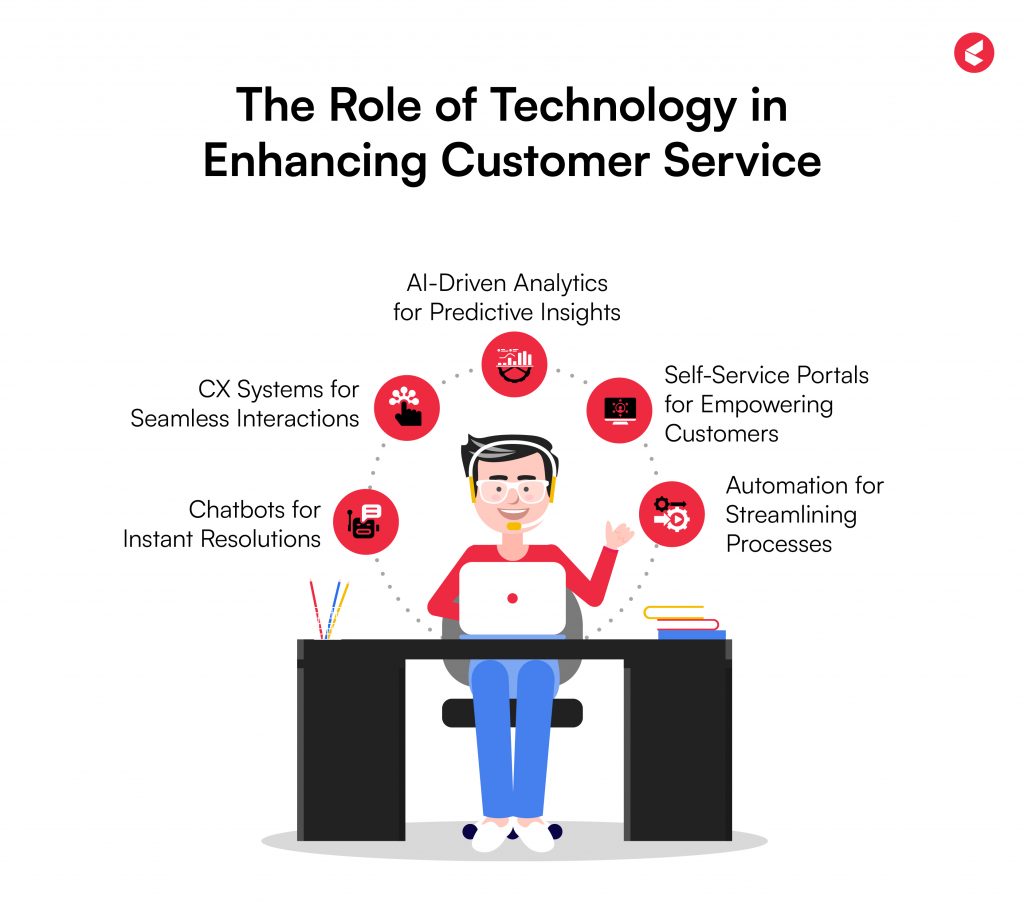
Technology has transformed the meaning of quality customer service, allowing companies to provide quicker, more tailored, and effective assistance. Instruments such as chatbots, CX systems, and AI-powered analytics are now essential for addressing changing customer expectations and ensuring excellent service quality.
1. Chatbots for Instant Resolutions
AI-driven chatbots deliver prompt and efficient responses to common inquiries, guaranteeing customer satisfaction. By functioning around the clock, they remove wait periods, enabling customers to receive help even beyond working hours.
For instance, an online retail company can utilize a chatbot to manage inquiries about order tracking and returns. This lessens the burden on human agents, allowing them to concentrate on intricate problems. Chatbots further improve customer experiences by providing immediate solutions, which are essential for promoting trust and loyalty.
2. CX Systems for Seamless Interactions
CX systems consolidate all customer information, providing agents with a cohesive perspective of engagements across different channels. This guarantees uniformity and individualization, essential components of excellent customer service.
For example, a travel agency utilizing a CX system can view a customer’s booking history to suggest suitable travel packages. CX systems also facilitate smooth transitions when customers move between channels, such as live chat and phone assistance. This holistic method enhances efficiency while guaranteeing that customers feel appreciated.
3. AI-Driven Analytics for Predictive Insights
AI-powered analytics help businesses anticipate customer needs and resolve potential issues proactively. By analyzing customer behavior, these tools provide actionable insights that enhance service quality.
For example, a subscription service can identify patterns in cancellations and address pain points before customers leave. AI also supports agents by suggesting personalized recommendations or responses during interactions, enabling a tailored approach that resonates with customers.
4. Self-Service Portals for Empowering Customers
Self-service portals allow customers to manage their own issues, decreasing reliance on live support agents. These gateways offer entry to information repositories, frequently asked questions, and problem-solving manuals.
For example, a software firm can provide an extensive help center where users can discover solutions to technical inquiries without reaching out to support. When executed properly, self-service tools conserve time for both customers and companies while boosting satisfaction by providing swift answers.
5. Automation for Streamlining Processes
Automation tools accelerate customer service’s repetitive and time-consuming tasks to ensure faster service delivery. For example, automated ticketing systems route customer queries to the right department or agent for quick resolution.
Other forms of business automation involve sending proactive updates, such as shipment notifications or reminders about upcoming payments. This keeps customers abreast of what is happening around them and shows a commitment to transparency and efficiency.
Conclusion
Effective customer service is an essential approach that improves satisfaction, loyalty, and brand image in competitive industries. By emphasizing empathy, active listening, and personalization, companies can surpass customer expectations and promote lasting success.
Technology enhances service quality by utilizing tools such as chatbots, AI analytics, CX systems, and self-service portals. Metrics like CSAT and NPS guarantee a customer-focused approach. Tackling issues like scalability and irregular communication necessitates empowering teams, establishing feedback loops, and providing omnichannel support.
Leverage Kapture CX to redefine customer service excellence. Its AI-led automation streamlines workflows by automating ticket routing and improving response times, enabling faster resolutions and heightened satisfaction. With omnichannel support, businesses can ensure seamless, personalized interactions across all customer touchpoints.
The platform’s actionable insights empower teams with data-driven strategies to tackle challenges and foster meaningful customer engagement proactively. Whether scaling operations, delivering 24/7 support, or enhancing communication, Kapture CX provides everything needed to excel in today’s competitive landscape.
Ready to elevate your customer service strategy? Explore how Kapture CX can transform your operations and give you a competitive edge. Contact us today to redefine customer experiences like never before!








